在過去的十年中,世界各地對安全和保障的重視程度不斷提高;這可以歸因於多種因素,包括不斷演變的威脅以及人們日益認識到防範和緊急應變的重要性。以恐怖主義和犯罪活動為特徵的不斷演變的威脅形勢極大地促進了人們對安全和保障的重視程度的提高。世界各國政府和組織都意識到需要加強安全措施來保護其公民、關鍵基礎設施和資產。
此外,全球越來越意識到需要做好準備並採取積極措施來確保社區的安全。這種意識促使政府、非政府組織(NGO)和私人實體增加對安全措施(包括搜救設備)的投資。重點是為緊急應變人員和搜救隊配備先進的工具和技術,以提高他們的能力和效率。
訪問完整報告@ https://www.databridgemarketresearch.com/reports/global-search-and-rescue-equipment-market
Data Bridge Market Research 分析,全球搜救設備市場預計在 2021 年至 2030 年的預測期內以 3.84% 的複合年增長率增長,預計到 2030 年將達到 108,809,847.93 萬美元。災害嚴重程度的增加預計會推動市場的成長,因為這會導致各國對其的需求不斷增加。
研究的主要發現
SAR設備技術進步的成長
技術進步是新技術或改進技術的開發和實施,為產品、解決方案以及與產品相關的服務帶來重大改進。在搜救設備方面,技術進步徹底改變了這些工具的能力和有效性,實現了更好的檢測、通訊和回應。搜救設備的技術進步使得能夠更快、更準確地發現、定位和救出遇險人員。提高效率意味著更快的反應時間,增加救援成功的機會並最大限度地降低潛在風險。此外,搜救設備的先進技術提高了救援人員和倖存者的安全性。例如,無人機可以評估危險或難以進入的區域,減少人類救援人員暴露於潛在危險的需要。這不僅保障了搜救人員的生命安全,也使搜救行動更有效率、更有效率。
技術進步為搜救隊提供了更好的態勢感知能力,使他們能夠做出明智的決定。它包括即時通訊系統和熱成像攝影機,這些進步有助於全面了解搜索區域,提高快速有效地定位和救援人員的機會。過去幾年搜索和救援設備的一些技術進步包括:
先進的通訊系統:技術進步促進了先進通訊系統的發展,例如衛星通訊設備和加密無線網路。這些系統實現了搜救隊之間的無縫、安全通信,有助於即時協調和資訊共享。
無人機技術:無人機透過提供空中監視、測繪以及到達偏遠或危險區域的能力,徹底改變了搜索和救援行動。無人機配備攝影機、熱成像感測器和 GPS 功能,可增強態勢感知能力,快速評估搜尋區域,並協助找到遇險人員。
熱成像攝影機:熱成像攝影機利用紅外線技術來檢測和顯示熱訊號。這些攝影機即使在光線不足或模糊的環境中也能識別人體熱量,這使得它們在搜索和救援行動中,特別是在尋找失踪人員或被困在廢墟中的倖存者時非常有用。
由於功能性和效率的提高,對先進設備的需求增加預計將推動市場成長。
報告範圍和市場細分
報告指標
|
細節
|
預測期
|
2021年至2030年
|
基準年
|
2022
|
歷史歲月
|
2021(可自訂 2015-2020)
|
定量單位
|
收入(千美元)、銷售(單位)、定價(美元)
|
涵蓋的領域
|
按類型(搜索設備、通訊設備、救援設備、技術設備、物流設備、醫療設備和規劃設備)、平台(機載、海上和地面)、應用(崎嶇地形、城市和郊區以及戰場)、最終用戶(國防、警察和國土安全、災害管理、消防部門和醫療保健/ EMS)
|
覆蓋國家
|
美國、加拿大、墨西哥、德國、法國、英國、義大利、西班牙、俄羅斯、土耳其、比利時、荷蘭、瑞士、歐洲其他地區、日本、中國、韓國、印度、澳洲、新加坡、泰國、馬來西亞、印尼、菲律賓、亞太其他地區、巴西、阿根廷、南美洲其他地區、南非、埃及、沙烏地阿拉伯、阿聯酋、以色列、中東和非洲其他地區
|
涵蓋的市場參與者
|
Cubic Corporation、Honeywell International Inc.、ACR Electronics Inc.、Textron Inc.、Leonardo SpA、Elbit Systems Ltd.、Aeromarine SRT、Thales、General Dynamics Corporation、Petzl、Raytheon Technologies Corporation、Savox Communications、Drägerwerk AG & Co。 GmbH、General Atomics、MRT、Avon Protection、LALIZAS、Cohort plc、Jotron 和 JW FISHERS 等
|
報告涵蓋的數據點
|
除了對市場價值、成長率、細分、地理覆蓋範圍和主要參與者等市場情景的洞察之外,Data Bridge Market Research 策劃的市場報告還包括深度專家分析、患者流行病學、管道分析、定價分析和監管框架。
|
細分分析:
全球搜救設備市場根據類型、平台、應用程式和最終用戶分為四個顯著的部分。
- 根據類型,市場分為搜尋設備、通訊設備、救援設備、技術設備、物流設備、醫療設備和規劃設備。
2023 年,搜尋設備領域預計將佔據市場主導地位
2023 年,搜尋設備領域預計將以 33.68% 的份額佔據市場主導地位,因為它在搜救行動中發揮關鍵作用,有助於識別、定位和營救遇險人員。這些工具和設備專門設計用於提高搜尋工作的效率和效果,增加成功的機會。
- 根據平台,市場分為機載、海上和地面。
預計 2023 年機載市場將佔據主導地位
到 2023 年,機載設備預計將佔據市場主導地位,佔 43.13%,因為它具有廣泛的覆蓋範圍和出色的機動性,使其在搜索和救援行動中非常有效。直升機和固定翼飛機可以迅速覆蓋廣大地區,包括其他方式難以到達的偏遠和難以到達的地方。這種廣泛的覆蓋能力增加了在較短的時間內找到並營救遇險人員的可能性。
- 根據應用,市場分為崎嶇地形、城市和郊區以及戰鬥地點。 2023 年,崎嶇地形領域預計將佔據市場主導地位,佔 47.20%,因為山脈、森林、沙漠或偏遠荒野地區等崎嶇地形發生事故和緊急情況的風險更高。這些充滿挑戰的環境經常吸引冒險愛好者、健行者、登山者和探險家,從而增加了在這些地區需要進行搜索和救援行動的可能性。崎嶇的地形難以預測,坡度陡峭,植被茂密,天氣條件極端,交通不便,需要專門的設備才能進行有效的搜救行動。
- 根據最終用戶,市場細分為國防、警察和國土安全、災害管理、消防部門、醫療保健/EMS 等。 2023 年,國防領域預計將佔據 38.73% 的市場份額,因為軍隊積極參與搜索和救援行動,包括作戰任務和人道主義援助,需要根據其獨特需求量身定制的專用設備。國防組織擁有強大的基礎設施、資源和經過搜救任務訓練的人員,能夠在各種地形上有效地進行行動。保護國家安全和主權的責任促使他們使用先進的搜救設備來保護軍事人員。國防組織也透過研發推動技術進步,尋求尖端技術來增強其能力。
主要參與者
Data Bridge Market Research 認為以下公司是全球搜尋和救援設備市場的主要市場參與者,包括 ACR Electronics, Inc.、Textron Inc.、Leonardo SpA、Elbit Systems Ltd.、Aeromarine SRT、Thales、General Dynamics Corporation、Petzl、Raytheon Technologies Corporation、Savox Communications、Drägerwerkport、S. K. Inc.、Safran、Becker Avionics GmbH、General Atomics、MRT、Avon Protection 等。
市場開發
- 2023 年 6 月,通用原子公司宣布其三名資深工程師獲得美國航空航天學會 (AIAA) 聖地牙哥分會的認可。這項認可凸顯了 GA-ASI 對全球搜救行動至關重要的 UAS 平台開發創新和技術卓越的承諾。這些工程師的專業知識和開創性工作推動了自動起飛和著陸能力 (ATLC) 等技術的進步,並成功管理了美國海軍陸戰隊的專案。這些成就進一步鞏固了 GA-ASI 在無人系統領域的領先地位,並增強了其致力於為全球搜尋和救援任務提供最先進解決方案的決心
- 2023年6月,LALIZAS在希臘埃伊納島成功舉辦首屆LALIZAS海事服務提供者高峰會。這項活動匯集了來自約 30 個國家的服務合作夥伴,進行了為期兩天的交流、演示和討論。此次高峰會為 LALIZAS 提供了一個機會,加強與海事服務提供者的合作,這些服務提供者在確保救生設備得到妥善維護方面發揮著至關重要的作用。關於消防安全與救援服務以及 F&I 救生筏交換的演示引起了熱烈的討論,並促進了寶貴見解的交流。本次峰將使LALIZAS與全球合作夥伴加強了溝通、建立了協同效應、進一步發展了合作。此次活動也展示了該公司致力於提供最優質安全產品和服務的承諾,鞏固了其在市場中的地位
- 2022 年 11 月,Teledyne FLIR LLC 推出了 MUVE R430 無人機感測器有效載荷,旨在遠端偵測和識別輻射源。 R430 整合到無人機系統 (UAS) 中,例如 SkyRanger R70 和 R80D SkyRaider。 R430 利用 Teledyne FLIR identiFINDER 系列的成熟技術,使用戶能夠快速精確地從遠處定位和識別放射源。透過可見和可聽的警報,操作員可以創建污染地圖、評估危險區域並在難以到達的環境中進行評估。 MUVE R430 緊湊而多功能的設計使其適用於危險品調查、緊急應變和環境監測。 Teledyne FLIR 持續擴展其智慧感測技術產品線,為全球搜救行動提供全面的任務解決方案
- 2021 年 5 月,Teledyne Technologies 完成對 FLIR Systems 的收購,成立 Teledyne FLIR LCC。 Teledyne FLIR 提供全面的成像技術,從 X 射線到紅外線,以及無人系統和成像有效載荷。該交易價值約 82 億美元,使 Teledyne FLIR 成為全球領先的搜尋和救援設備供應商
- 2020 年 5 月,Savox Communications 宣布芬蘭國防軍已行使額外購買士兵路由器的選擇權。這份價值 200 萬歐元的訂單鞏固了 Savox 作為軍方值得信賴的合作夥伴的地位,提供先進的通訊解決方案。士兵路由器是與芬蘭國防軍密切合作開發的,它增強了態勢感知能力,並能夠將現有的現場無線電整合到現代指揮和控制系統中。此次合作證明了 Savox 能夠將現有技術與新技術無縫結合,滿足國防組織不斷變化的需求。 Savox 始終致力於為全球搜救行動提供創新解決方案
區域分析
從地理上看,全球搜救設備市場涵蓋的國家有美國、加拿大、墨西哥、德國、法國、英國、義大利、西班牙、俄羅斯、土耳其、比利時、荷蘭、瑞士、歐洲其他地區、日本、中國、韓國、印度、澳洲、新加坡、泰國、馬來西亞、印尼、菲律賓、亞太其他地區、巴西、阿根廷、其他地區、南非、埃及、阿拉伯、阿聯酋其他地區、以色列、中東和其他地區。
根據 Data Bridge 市場研究分析:
北美是主要地區,預計在 2021 年至 2030 年預測期內將成為全球搜尋和救援設備市場成長最快的地區。
北美地區預計將佔據市場主導地位,因為該地區非常重視技術進步和創新,特別是在航空航太、國防和緊急應變等領域。這種技術實力使北美公司能夠開發和提供滿足不斷變化的市場需求的尖端搜尋和救援設備。在北美,由於搜救設備技術的不斷進步,美國預計將主導北美搜救設備市場。
2023年,北美將成為全球搜救設備市場的主要地區,預計成長速度最快。
2023年,北美預計將成為全球搜救設備市場成長最快的地區,因為北美先進的技術能力對市場有直接的影響。先進的通訊系統、GPS追蹤設備、無人機、熱成像攝影機等設備的不斷創新,提高了搜救行動的效率和效果。
有關全球搜尋和救援設備市場報告的更多詳細信息,請點擊此處 - https://www.databridgemarketresearch.com/reports/global-search-and-rescue-equipment-market












